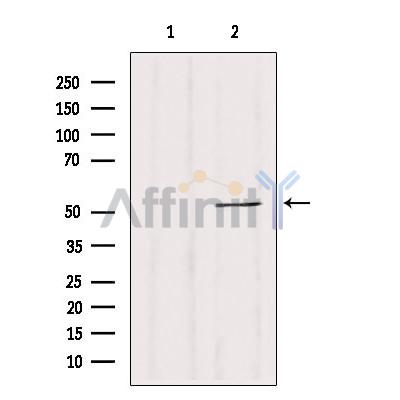产品描述
*The optimal dilutions should be determined by the end user. For optimal experimental results, antibody reuse is not recommended.
*Tips:
WB: 适用于变性蛋白样本的免疫印迹检测. IHC: 适用于组织样本的石蜡(IHC-p)或冰冻(IHC-f)切片样本的免疫组化/荧光检测. IF/ICC: 适用于细胞样本的荧光检测. ELISA(peptide): 适用于抗原肽的ELISA检测.
引用格式: Affinity Biosciences Cat# DF12360, RRID:AB_2845165.
展开/折叠
Antigen nuclear dot 52 kDa protein; CACO2_HUMAN; Calcium binding and coiled coil domain 2; Calcium binding and coiled coil domain containing protein 2; Calcium-binding and coiled-coil domain-containing protein 2; CALCOCO 2; CALCOCO2; MGC17318; NDP52; Nuclear domain 10 protein 52; Nuclear domain 10 protein; Nuclear domain 10 protein NDP52; Nuclear domain protein 52; Nuclear dot protein 52; OTTHUMP00000218344; OTTHUMP00000218345; OTTHUMP00000218346; OTTHUMP00000218347; OTTHUMP00000218349; OTTHUMP00000218351;
抗原和靶标
A synthesized peptide derived from human CALCOCO2, corresponding to a region within the internal amino acids.
Expressed in all tissues tested with highest expression in skeletal muscle and lowest in brain.
- Q13137 CACO2_HUMAN:
- Protein BLAST With
- NCBI/
- ExPASy/
- Uniprot
MEETIKDPPTSAVLLDHCHFSQVIFNSVEKFYIPGGDVTCHYTFTQHFIPRRKDWIGIFRVGWKTTREYYTFMWVTLPIDLNNKSAKQQEVQFKAYYLPKDDEYYQFCYVDEDGVVRGASIPFQFRPENEEDILVVTTQGEVEEIEQHNKELCKENQELKDSCISLQKQNSDMQAELQKKQEELETLQSINKKLELKVKEQKDYWETELLQLKEQNQKMSSENEKMGIRVDQLQAQLSTQEKEMEKLVQGDQDKTEQLEQLKKENDHLFLSLTEQRKDQKKLEQTVEQMKQNETTAMKKQQELMDENFDLSKRLSENEIICNALQRQKERLEGENDLLKRENSRLLSYMGLDFNSLPYQVPTSDEGGARQNPGLAYGNPYSGIQESSSPSPLSIKKCPICKADDICDHTLEQQQMQPLCFNCPICDKIFPATEKQIFEDHVFCHSL
研究背景
Xenophagy-specific receptor required for autophagy-mediated intracellular bacteria degradation. Acts as an effector protein of galectin-sensed membrane damage that restricts the proliferation of infecting pathogens such as Salmonella typhimurium upon entry into the cytosol by targeting LGALS8-associated bacteria for autophagy. Initially orchestrates bacteria targeting to autophagosomes and subsequently ensures pathogen degradation by regulating pathogen-containing autophagosome maturation. Bacteria targeting to autophagosomes relies on its interaction with MAP1LC3A, MAP1LC3B and/or GABARAPL2, whereas regulation of pathogen-containing autophagosome maturation requires the interaction with MAP3LC3C. May play a role in ruffle formation and actin cytoskeleton organization and seems to negatively regulate constitutive secretion.
Cytoplasm>Perinuclear region. Cytoplasm>Cytoskeleton. Cytoplasmic vesicle>Autophagosome membrane>Peripheral membrane protein.
Note: According to PubMed:7540613, localizes to nuclear dots. According to PubMed:9230084 and PubMed:12869526, it is not a nuclear dot-associated protein but localizes predominantly in the cytoplasm with a coarse-grained distribution preferentially close to the nucleus.
Expressed in all tissues tested with highest expression in skeletal muscle and lowest in brain.
The MYO6-binding domain is required for autophagy-mediated degradation of infecting bacteria such as Salmonella typhimurium, but not for bacteria targeting to autophagosomes.
The CLIR (LC3C-interacting region) motif is required for interaction with MAP1LC3C, but dispensable for CALCOCO2-mediated autophagosome maturation.
The LIR-like motif is required for interaction with MAP1LC3A, MAP1LC3B and GABARAPL2, as well as for CALCOCO2-mediated autophagosome maturation.
The LGALS8-binding domain is essential for the recruitment to cytosol-exposed infecting bacteria.
Belongs to the CALCOCO family.
文献引用
限制条款
产品的规格、报价、验证数据请以官网为准,官网链接:www.affbiotech.com | www.affbiotech.cn(简体中文)| www.affbiotech.jp(日本語)产品的数据信息为Affinity所有,未经授权不得收集Affinity官网数据或资料用于商业用途,对抄袭产品数据的行为我们将保留诉诸法律的权利。
产品相关数据会因产品批次、产品检测情况随时调整,如您已订购该产品,请以订购时随货说明书为准,否则请以官网内容为准,官网内容有改动时恕不另行通知。
Affinity保证所销售产品均经过严格质量检测。如您购买的商品在规定时间内出现问题需要售后时,请您在Affinity官方渠道提交售后申请。产品仅供科学研究使用。不用于诊断和治疗。
产品未经授权不得转售。
Affinity Biosciences将不会对在使用我们的产品时可能发生的专利侵权或其他侵权行为负责。Affinity Biosciences, Affinity Biosciences标志和所有其他商标所有权归Affinity Biosciences LTD.

